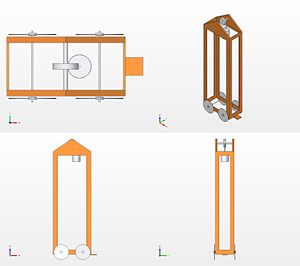Zero Cost Scrambler
This article documents a design not compatible with current event rules. |
This page has to do with the Scrambler event.
Overview
With any building event, the funds available, personal or otherwise, have a large impact on the type of device that you are able to create. Lack of funding, however, does not prevent you from entering a reasonably competitive device. This article is about approaches and designs that are low or no cost, but allow the participant to enter a functional device.
The K'nex Scrambler
It is an excellent bet that someone on your team owns a box of K'nex. K'nex have a huge advantage over many other building substances in that they allow you to build lightweight, relatively stable, tall towers with very few pieces. Building a meter tall tower out of Legos would present a large number of monetary, structural, and weight difficulties. Wood scrap can also be used, but requires some small woodworking skill, so this will be solely addressing K'nex.
The goal is to replicate this type of device:
With K'nex:
Theory of Operation
- The falling mass starts at the top of (or partway up) the tower and has a string tied to it that travels over a pulley at the top and down to the driving axle, where it wraps around a number of times and is then anchored to the axle.
- You change your scrambler to match the target distance by winding the string around the axle a different number of rotations. More rotations = more distance.
- As the weight falls, it forces the string to unwind off of the driving axle, making the wheels spin.
The Tower
- Build to the maximum height limit
- Add cross bracing to keep the tower from twisting
- Keep the interior as snag-free as possible to prevent the string or weight from getting hung up
- Add a pulley at the very peak of the tower in the center
- K'nex may not be strong enough for the pulley's axle, so you may have to use a pencil or small dowel/metal rod
The Wheels
- Based on the MAX HEIGHT and MAX TRACK distances for the year, along with your drive axle's circumference, determine the minimum size for your wheels.
- The number of wraps the string can make around your axle depends on the height of the tower and the circumference of the axle. Larger axles will provide more torque, but less distance.
- The size of the wheels will determine how far your device travels per axle wrapping. Larger wheels will let you go farther, but at the cost of torque.
- K'nex makes a variety of wheels and, as long as they are big enough, they will get you the distance.
- As long as you don't mind losing some K'nex to the terrors of hot glue, you can easily attach any number of wheel-alternatives to your axles. CDs and 7" vinyls (grandma's house) come to mind.
The Falling Mass
- The mass pictured above was made out of a tin can, marbles, duct tape, and a coat hanger.
- Improvise or steal from your physics teacher.
The Backstop
- This has become more challenging in the recent seasons because of the strict dimension requirements that have been imposed.
- Use wood, metal, or hard plastic. Don't leave any room to let it be ruled "not smooth" or "not rigid".
- Find a piece of strap wood and cut it down to size.
- Apply lots of hot glue.
The Brakes
- Braking is the hardest part of a K'nex scrambler.
- The simplest solution is to let the weight hit the ground and drag (the scrambler will stop when the weight hits the rear axle).
- Consider more complex breaking systems, like the weight pressing a high-friction pad to the floor, only if you have the time.
Testing
- Low-cost is not synonymous with "failure" or "broken egg", but it will be if you don't adequately test the device.
- If you are just letting the weight drag the tower to a stop, your breaking distance will vary with speed. This means you cannot simply extrapolate for the entire course based on two measurements.
- Do test runs at half meter intervals.
- AIM to fall SEVERAL inches short - you do not have the best breaking system out there, even if you went with a more complex one. You can't stop on a dime. You don't want to break the egg, so don't risk it.
Weaknesses in the Design
- Brakes have already been mentioned as a problem area.
- Because your scrambler is running off of a constant force throughout the entire run, rather than a high initial force, it will take you a lot longer to get up to your highest velocities. You can help this by wrapping the string around a cone or series of disks of decreasing diameter:
This lets the scrambler have more initial torque when it is starting out, but then moves to "cruising speed"
Conclusion
- This scrambler design works
- It isn't the best, but it doesn't really cost you anything to build.
- You can make it in an hour or two, excluding testing
- You get to compete and earn your team points.






